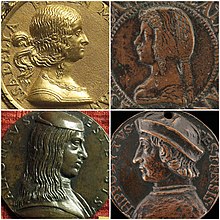Ippolito d'Este
Ippolito (I) d'Este (Hungarian: Estei Hippolit; 20 March 1479 – 3 September 1520) was an Italian Roman Catholic cardinal, and Archbishop of Esztergom.
Ippolito nonetheless departed Ferrara for Hungary on 18 June 1487, accompanied by his cousin, Bishop Nicolò Maria d'Este of Adria; the departure was noted by Marino Sanuto in his Diarii, who traces his journey through Rovigo and Padua.
His aunt married her late husband's competitor and successor, Vladislaus Jagiellon, King of Bohemia, who brought different policies and different personnel into the kingdom.
Three years later Ippolito returned to Italy to escape the plague that was striking Hungary; he arrived in Rome with a following of 250 people.
D'Este was created cardinal by Pope Alexander VI on 20 September 1493, and named Cardinal-Deacon of S. Lucia in Silice three days later,[6] after which he resided in Rome.
According to the tax reports of the Curia for the year 1500, he was the fifth richest member of the College of Cardinals, in terms of annual income.
[8] His influence grew further when his brother Alfonso married Lucrezia Borgia, daughter of Alexander VI, who granted him the title of archipresbyter of St. Peter's on 11 August 1501.
On 12 July Cardinal Orsini sought an audience with Pope Alexander to get permission to go to Milan to negotiate with King Louis XII.
Cardinal Ippolito was not able to return to Rome until 28 October, and then with a broken leg from a fall from his horse, because of which he had been absent from the Conclave of 16–22 September 1503.
Cardinal Tamás Bakócz, Archbishop of Esztergom and Chancellor of Hungary (on account of which he did not attend the conclaves), wrote a letter to the Signoria of Venice, which Marino Sanuto saw on 23 November 1503.
In his letter, which was purely concerned with benefices, he wanted the Signoria to get Cardinal d'Este to resign the Bishopric of Eger.
[18] When Pius III died on 18 October, d'Este was able to participate in the second Conclave of 1503, at which Cardinal Giuliano della Rovere was elected Pope Julius II on 1 November.
After the Conclave and the Coronation (26 November), Cardinal Ippolito was reported to be ill and did not attend the papal ceremonies of taking possession of his cathedral church of Saint John Lateran on 5 December 1503.
On 24 May he was in Milan and took part in the formal reception of King Louis XII of France, along with Cardinals Georges d'Amboise, Clermont de Castelnau, Pallavicini, Caretto, San Severino, and Trivulzio.
[27] The Cardinal successfully led a military contingent to regain the Polesine territories that the Este had lost in the war with Venice in 1484, winning the decisive battle of Polesella.
In May 1510, upon the death of Cardinal Giuliano Cesarini, the office of Abbot Commendatory of the Abbazia di Nonantola (diocese of Modena) became vacant.
[29] D'Este's brother Alfonso later convinced him to disassociate himself from the schism, and Pope Julius authorized him to return to Ferrara.
On 7 April 1518, the Cardinal left Eger to go to Cracow for the marriage of King Sigismund and Bona, the daughter of Gian Galeazzo Sforza, who also happened to be a niece of the Emperor Maximilian.
[35] On Friday 10 August the Cardinal took a long walk of some five miles (eight km) to a property of his at Baura, east of Ferrara.
On Sunday he took a walk to his property at Sabioncello, a distance of twelve miles, but he felt troubled the whole day; he was advised to return to Ferrara and avoid the heat.
The Duke made the Castel Nuovo on the Po available to Ippolito, where he remained ill until Friday, 31 August, when he got out of bed in the morning, feeling in much better spirits.
In Rome, on 5 September, Pope Leo X was trying to divide up the late Cardinal's benefices, in the midst of three attacks of tertian fever.

